S.S. Perro (Design 1001, EFC Hull 355)
Perro was laid down on 12 February 1918 and is shown here on 27 May 1918 in frame looking forward at the Southern D.D. & S.B. Co. of Orange, Texas. Her EFC hull number is displayed in the middle of the image. This yard succeeded in completing as steamers only two of the ships in its contracts for ten, and Perro, the fifth ship, was finally launched as a flush deck barge on 19 August 1919 and delivered to the EFC in October 1919.
Photo No. 165-WW-503H-002
Source: NARA: RG-165
|
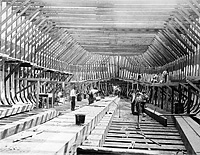 |
Barge Fort Shaw (ex Design 1001, Hull 2138)
This vessel was ordered from the St. Helens S.B. Co of St. Helen's, Ore., as a Ferris cargo ship, designated in March 1919 for completion as a flush deck barge retaining her poop and forecastle, and delivered in August 1919 with four masts stepped in bald-headed schooner fashion (without topsails). This image and the accompanying text, which provides background on the barge conversions, is from The Sunday Oregonian, 17 August 1919, Section Two, Page 22, Image 46.
Photo No. None
Source: oregonnews.uoregon.edu/lccn/sn83045782/1919-08-17/ed-1/seq-46.pdf
|
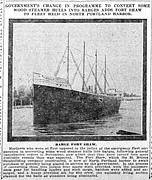 |
Barge Fort Shaw
Captioned as a "sailing vessel" but actually a Design 1001 steamer hull delivered as a 4-masted flush deck schooner barge, this vessel was photographed on 28 February 1920 in the storage yard in North Portland Harbor (in the Columbia Slough), Portland, Ore. To starboard are the Design 1003 hull Alleben (EFC Hull 667, Design 1003, ordered converted to a barge but still with her bridge house) and beyond her the Design 1001 hull Aburia (Hull 2273). Astern of these three vessels is another nest including the Design 1001-TS hull Montezuma (EFC Hull 18), a twin screw variant of Design 1001, built by the G.M. Standifer Construction Corp. at Portland, Ore.
Photo No. None
Source: NARA: RG-32-M box 3
|
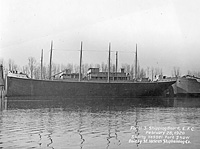 |
Barge Acarman (ex Design 1001, Hull 2272)
Delivered in July 1919 by the Grant Smith-Porter Ship Co. at Portland, Ore., as a flush deck barge without masts in the "poop and forecastle" configuration and photographed on 28 February 1920 in the storage yard in North Portland Harbor, Portland, Ore. She was later sold and completed privately in 1921 by G. F. Matthews of Portland as the 5-masted schooner Undaunted. To port is an unidentified vessel delivered as an unrigged flush deck barge and outboard of it the Design 1001 hull Onteora (EFC Hull 1460) with two masts up. The ship hull aft of Acarman, also with two masts up, is Aburia, and the four masts near her belong to the flush deck barge Fort Shaw.
Photo No. None
Source: NARA: RG-32-M box 3
|
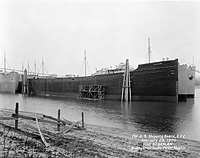 |
Barge Acarman
Looking aft in the North Portland Harbor storage yard on 28 February 1920 with an unrigged flush deck barge and the Design 1001 hull Onteora to port. The vessels behind Acarman are, from left to right, Aburia, Alleben, and Fort Shaw. Onteora was built by the Wilson S.B. Co. of Astoria, Oregon; Aburia was built by Grant Smith-Porter in Aberdeen, Washington, and Alleben (Design 1003, Hough type) was built by the McEachern Ship Co. of Astoria, Ore.
Photo No. None
Source: NARA: RG-32-M box 3
|
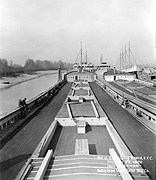 |
Barge Fort Shaw
Photographed on 28 February 1920 in the North Portland Harbor storage yard showing her four bald-headed schooner masts and her cargo hatches. Note also the details of the bridge house of the Design 1003 (Hough) hull Alleben to starboard. Ahead of Fort Shaw was the nest containing Acarman, and beyond that was a nest of three ships with the four masts of the barge Daulis (EFC Hull 2523), built by the Sommarstrom S.B. Co. of Columbia City, Ore., visible between two Design 1001 hulls. There were three more Design 1001 hulls ahead of these.
Photo No. None
Source: NARA: RG-32-M box 3
|
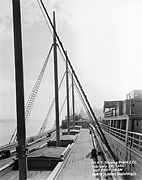 |
Barge Fort Shaw
Photographed on 28 February 1920 in the North Portland Harbor storage yard. This is the shelter for the crew that was fitted on the poop of the Design 1001 flush deck schooner barges in place of the much larger bridge house amidships on the steamers. Vessels at the North Portland Harbor storage yard not already mentioned included the steamer hulls Akanaquint (EFC Hull 2817), Arvonia (Design 1001-TS, Hull 20, sister to Montezuma), Bedloe (Hull 542), Fort Sheridan (Hull 2137), and Wabanaquot (Hull 2816), and the barges Aroturus (Design 1003, Hull 668) and Cabria (Hull 2311). Aroturus was a sister of Alleben and like her was ordered converted to a barge but was instead laid up incomplete with her bridge house still in place.
Photo No. None
Source: NARA: RG-32-M box 3
|
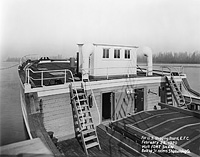 |
Lake Union Storage Yards, Seattle, Washington
By March 1919 the EFC was cancelling contracts and negotiating payments for unfinished ships. In May 1919 the Shipping Board ran ads across the country offering unfinished ships for sale. The list included unfinished wooden ships from yards in Tacoma, Seattle, Bellingham, Aberdeen, Raymond, Vancouver, and Grays Harbor. By August 1919 the Shipping Board had gathered 46 or 48 unfinished wooden ships (the photo shows about 43) from yards throughout the region for storage at Lake Union in Seattle, where a Congressional investigating committee inspected them that month. The North Portland Harbor storage yard or mooring grounds was probably formed at the same time.
Photo No. NH 43179
Source: NHHC.
|
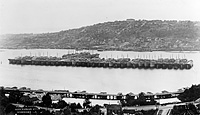 |
Lake Union Storage Yards, Seattle, Washington
A detail from the above image. There is not a single smokestack in the entire group, indicating that none had engines installed, and inclined covers were instead placed over the stack openings. Some ships were delivered with incomplete bridge houses and some were delivered as flush deck barges without bridge houses (although these conversions retained their forecastles and poops).
Photo No. NH 43179 (detail)
Source: NHHC. See also www.chriserlich.com/single-post/2018/10/04/solving-the-puzzle-of-a-misidentified-photo [not this one] and The Oregon Daily Journal, August 31, 1919, page 24.
|
 |
S.S. Abantis (Design 1001, Hull 2275)
Many ships never even got to a storage yard. Abantis was laid down on 31 December 1918 by the Grant Smith-Porter Ship Co. at Portland, Ore., and is shown here on 5 February 1919 in frame looking aft. Her construction was suspended on 3 March 1919 and cancelled on 25 March 1919, the frame being dismantled on the ways.
Photo No. None
Source: NARA: RG-165 (album)
|
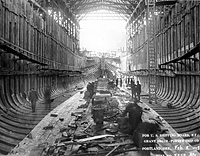 |










